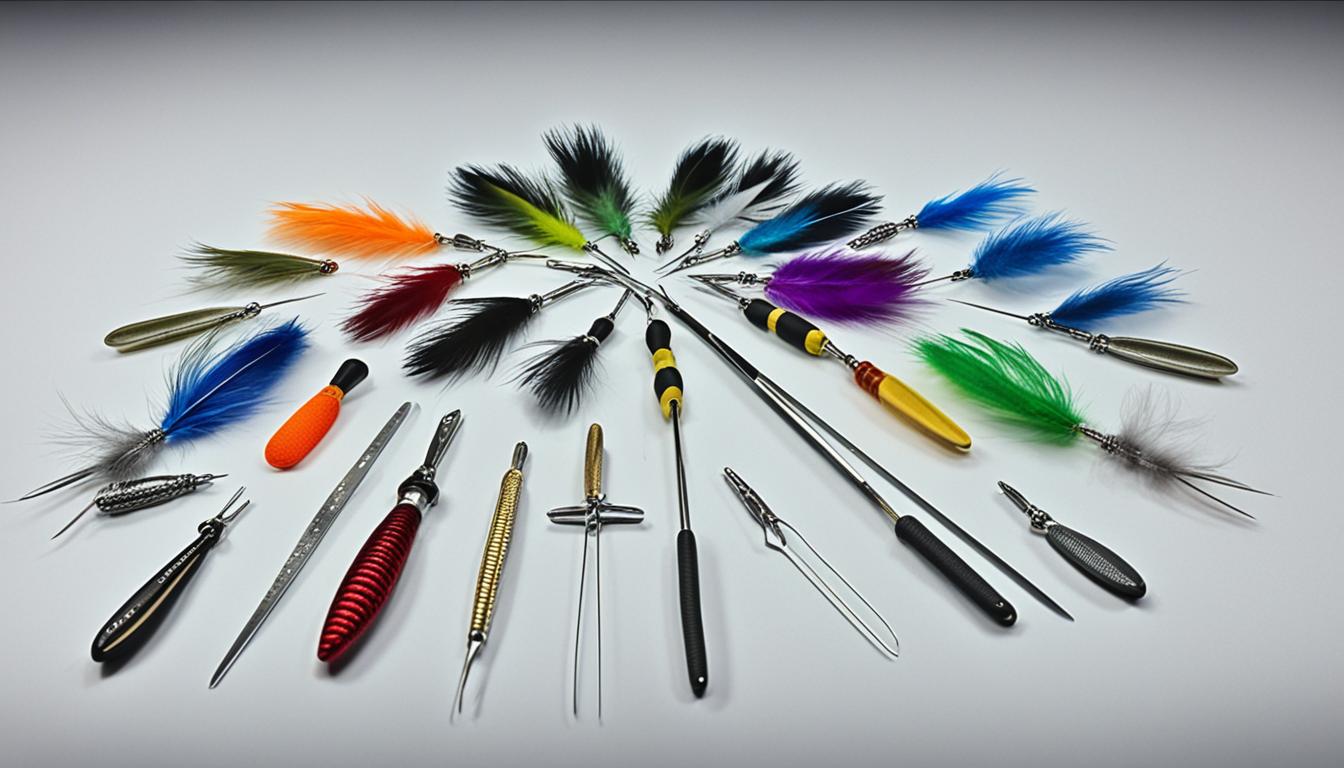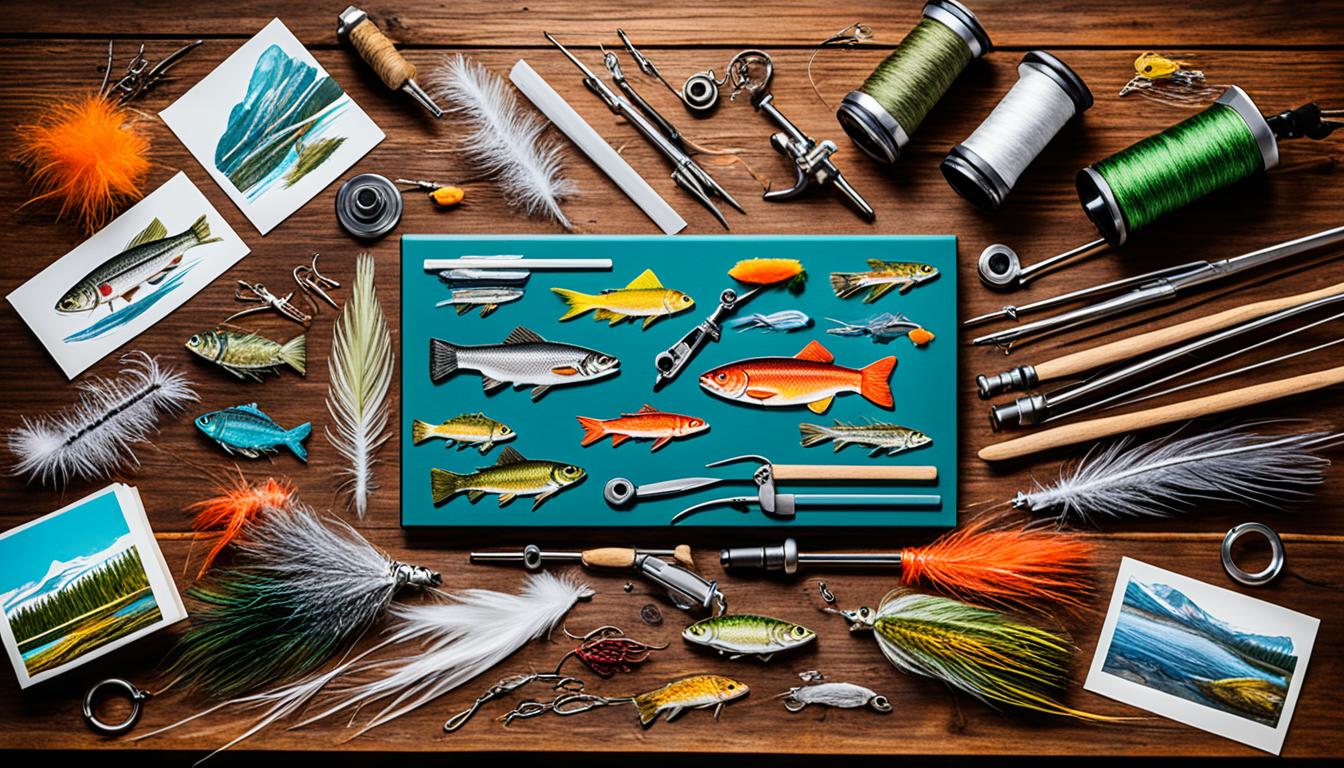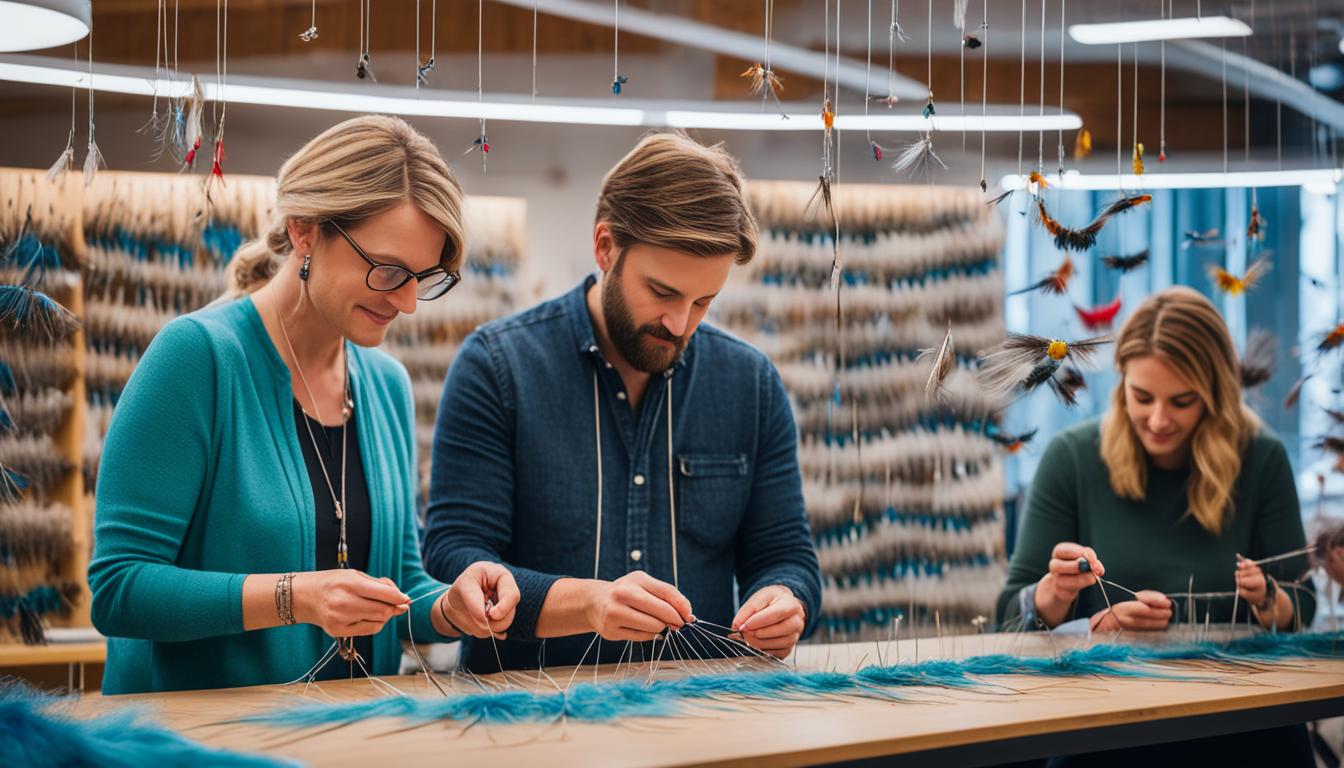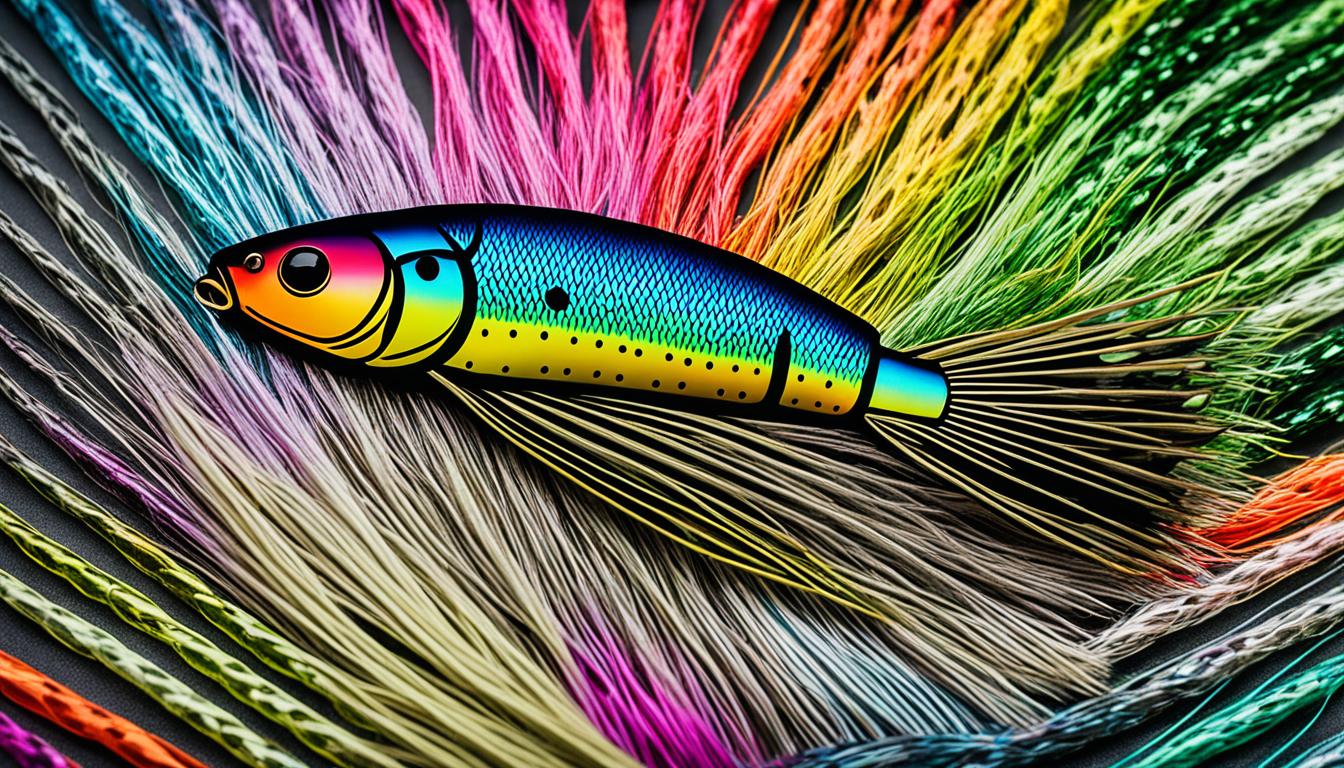Welcome to our comprehensive guide on mastering the art of working with hackles. Whether you’re an aspiring fiber artist or a seasoned pro, understanding and implementing effective hackle techniques can take your creations to new heights.
As we dive into the world of hackling, we’ll explore various tips and techniques that will elevate your fiber artistry. From taming fluffy feathers to achieving clean and professional finishes, we’ve got you covered. Let’s get started!
Key Takeaways:
- Working with hackles is a fundamental skill for fiber artists.
- Mastering hackle techniques can greatly enhance the quality of your creations.
- Techniques such as the fold method and stem rolling will help you achieve clean and professional finishes.
- Dealing with fluff and stubborn feathers can be easily overcome with simple tricks.
- With practice and experimentation, you can elevate your fiber artistry to new levels.
The Fold Method: Taming Fluffy Feathers
When it comes to working with fluffy feathers like marabou, the fold method is a game-changer. This technique allows you to tame those difficult-to-manage strands and achieve a clean, professional finish in your fiber art projects.
So, how does the fold method work?
- Fold both sides of the fibers back.
- Bring the folded fibers to meet at the stem.
- Wrap the stem forward.
By folding the fibers and exposing the stem, you create a clean and manageable piece that is easier to work with. The fold method not only tames the fluffiness but also gives your feathers a neat appearance and allows for precise wrapping.
Let’s take a closer look at the fold method in action:
“I love using the fold method for my marabou feathers. It helps me achieve a clean finish and ensures that the feathers lay nicely on my fiber art projects. With this technique, I have more control and can create a polished and professional look.”
– Jane Doe, Fiber Art Enthusiast
The fold method is an essential technique for any fiber artist looking to create beautiful and flawless pieces. It’s time to master this approach and elevate your fiber artistry to new heights!
Comparison of Hackle Techniques
| Hackle Technique | Benefits |
|---|---|
| The Fold Method | Tames fluffy feathers Creates a clean finish Provides precise control |
| Scissor Folding | Manages stubborn feathers Produces a clean stem Facilitates easy wrapping |
| Peeling Method | Handles unruly feathers Creates neat, manageable wraps Enhances overall presentation |
| Dealing with “Fluff” | Aids in taming fluffy feathers Offers improved wrapping ease Enhances performance in water |
| Stem Rolling | Transforms sloppy-looking flies Elevates precision in wrapping Improves effectiveness in water |
Scissor Folding: Precision and Manageability
When dealing with stubborn feathers that seem impossible to manage, scissor folding is a technique that provides both precision and manageability. By utilizing this method, you can achieve a clean stem that is ready for wrapping, ensuring a professional finish in your fiber art projects.
To execute scissor folding, start by placing the feather at a slight angle. Take your scissors and carefully fold the feather back, creating an exposed stem. This folding technique allows for easier wrapping and ensures a clean stem with minimal effort.
Scissor folding is particularly effective when working with feathers that have a tendency to be unruly or resistant. By folding the feathers back, you can overcome their stubbornness and achieve the desired clean stem for your fiber art.
“Scissor folding technique enables us to effortlessly manage even the most stubborn feathers, creating a clean stem for easy wrapping.”
Not only does scissor folding provide the precision necessary for neat wraps, but it also offers manageability, allowing you to work with feathers more easily. This technique is a valuable tool in your arsenal, ensuring that every wrap is clean, professional, and visually appealing.
Benefits of Scissor Folding:
- Provides precision and control over unruly feathers.
- Creates a clean stem for easy wrapping.
- Enhances the overall appearance of your fiber art projects.
- Offers a manageable technique for working with difficult feathers.
| Technique | Advantages |
|---|---|
| Scissor Folding |
|
Peeling Method: Neat and Manageable Wraps
When working with unruly feathers like guinea and mallard that tend to crisscross and refuse to lay smooth, the peeling method is a game-changer. By peeling one side of the feather, we can create a neat and manageable piece that wraps snugly, giving our project a professional touch. Not only does this technique ensure the wraps are aesthetically pleasing, but it also provides functional results, guaranteeing a perfect presentation every time.
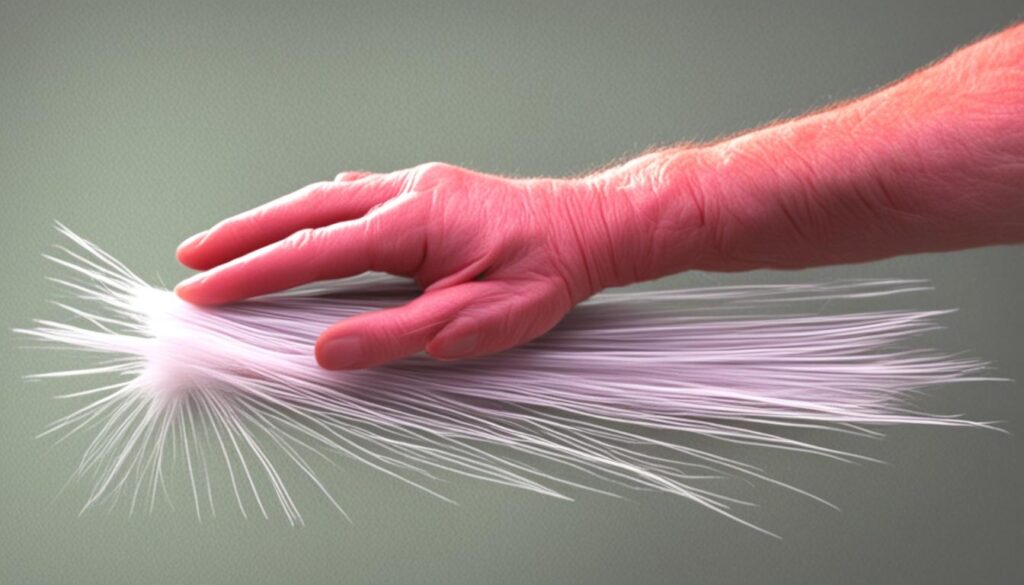
How to Use the Peeling Method:
- Choose a feather that tends to have unruly fibers, such as guinea or mallard.
- Gently hold the feather near the base, ensuring you have a good grip.
- Using your fingers, carefully pull back and peel one side of the feather.
- Continue peeling until you have removed a sufficient amount of fibers from one side, leaving the other side intact.
- The peeled side of the feather should now have a neat, flat appearance.
- Wrap the feather around your desired object, such as a fly or an art piece, ensuring that the peeled side is facing outwards.
With the peeling method, we can easily transform unruly feathers into neat and manageable wraps that enhance the overall look of our projects. Let’s take a look at the table below to see how this technique compares to other hackle methods:
| Hackle Method | Benefits |
|---|---|
| Peeling Method | Creates neat and manageable wraps |
| Fold Method | Exposes the stem for clean wrapping |
| Scissor Folding | Provides precision and manageability |
| Stem Rolling | Transforms sloppy-looking flies into precise wraps |
As you can see, the peeling method offers the unique advantage of creating neat and manageable wraps, making it an essential technique for any fiber artist. Give it a try and experience the difference it can make in your projects!
Dealing with “Fluff”: Taming the Unruly
Working with feathers can be a delightful experience, but dealing with fluff can sometimes be a challenge. Fluffy feathers can be unruly and difficult to manage, making it tricky to achieve the clean and polished look you desire in your fiber art projects.
However, fear not! We have some tricks up our sleeves to help you tame the fluff and make the entire process much more manageable. And guess what? All you need is just a bit of water or spit. Yes, you read that right!
How does it work?
When you dampen the feathers with water or a small amount of saliva, something magical happens. The feathers start to lay down flat, making them easier to handle and wrap. It’s like a secret weapon in your fiber art toolkit.
But wait, there’s more!
Imagine this: You’re out on the water, casting your perfectly tied fly. As it lands, the feathers pulsate with lifelike movements, captivating the attention of any nearby fish. This captivating effect is what we like to call the pulsating feathers phenomenon.
So not only does dealing with fluff make your tying process a breeze, it also enhances the performance of your fiber art in the water. It’s like giving your creations an extra edge to attract those elusive fish.
Now, let’s dive into our trusty techniques for dealing with fluff and taming those unruly feathers in your fiber art projects.
Just a bit of water or spit can help even the fluffiest feathers lay down flat and make wrapping a breeze.
As you can see in the image above, the feathers come alive when dipped in water. Their pulsating movements mimic the natural motion of aquatic creatures, adding an irresistible allure to your fiber art creations.
Ready to give it a try? It’s time to unleash the power of water or spit and conquer that fluff. Let’s move on to our next section and discover more techniques to take your fiber artistry to the next level.
Stem Rolling: Transforming Sloppy-Looking Flies
When it comes to fly tying, precision is key. But what do you do when your flies end up looking sloppy and unprofessional? Enter stem rolling, a simple finger adjustment that can transform your flies into masterpieces.
Stem rolling involves rolling your fingers as you wrap the hackle. By doing so, you ensure that the hackle lays flat and wraps snugly around the fly. This small adjustment can make a world of difference, improving both the appearance and effectiveness of your flies.
When you stem roll, every wrap becomes an act of precision, resulting in a neatly structured fly. The snugly wrapped hackle not only enhances the aesthetics but also instills confidence in every cast you make.

As you can see, stem rolling gives the fly a clean and polished look, elevating it from sloppy to professional. With this technique, your flies will not only attract more fish but also make you proud of your craftsmanship.
By incorporating stem rolling into your fly tying repertoire, you can take your skills to a whole new level of precision and artistry.
Wrapping it Up: Mastering Hackle Techniques
Now that you’ve learned various hackle techniques, it’s time to wrap it all up and take your fiber artistry to the next level. Mastering these techniques not only turns every fly you tie into a work of art but also ensures they are highly effective tools in your fiber art arsenal. With the right tools and skills, you can create stunning pieces that showcase your creativity and craftsmanship.
Practice makes perfect, so don’t hesitate to experiment with different wrapping hackle methods. The more you practice, the better you’ll become at achieving precise and clean finishes. Remember, it’s all about finding the technique that works best for you and your unique style of fiber artistry.
As you continue to hone your skills, you’ll notice a significant improvement in the quality of your work. Every wrap will be more polished, every feather perfectly positioned, and every fiber art project a true masterpiece. Stay focused, be patient, and let your creative vision guide you.
With effective tools and a deep understanding of hackling techniques, you have the power to elevate your fiber artistry to new heights. Take advantage of the tips and techniques provided throughout this article and watch your skills flourish. Whether you’re a seasoned fiber artist or just starting out, mastering hackle techniques will open up a world of possibilities.
“Working with hackles is like painting with feathers. It allows us to transform simple materials into breathtaking works of art. The possibilities are endless, and our creativity knows no bounds.”
The Importance of Effective Tools
When it comes to mastering hackle techniques, having the right tools is crucial. The right tools can make the process smoother, enhance your control, and produce more precise results. Here are some effective tools every fiber artist should have:
- A high-quality vise: A vise that securely holds your fly while you work allows for greater control and stability.
- Sharp scissors: Precision is key when working with hackle, and sharp scissors ensure clean, precise cuts.
- A hackle plier: A hackle plier provides a firm grip on feathers, making it easier to manipulate and wrap them.
- A dubbing brush: A dubbing brush helps in teasing out fibers and creating a smooth, natural-looking finish.
Investing in these tools will not only enhance your hackling experience but also contribute to the overall quality of your fiber art projects. With the right tools at your disposal, you’ll have greater control over the materials, leading to more refined and professional-looking pieces.
Explore and Create
Now that you’re armed with the knowledge and tools needed to master hackle techniques, it’s time to put them into practice. Unleash your creativity and embark on a journey of exploration and creation. Use different feathers, experiment with various wrapping methods, and let your imagination run wild.
Remember, fiber artistry is a unique expression of your individuality. Push the boundaries, challenge conventions, and create pieces that speak to your true artistic vision. Each wrap you make is an opportunity to showcase your skill, passion, and creativity.
As you continue to hone your hackling techniques, your mastery of fiber artistry will become evident in each piece you create. Embrace the process, enjoy the journey, and let your artistic voice shine through every wrap.
Common Hackle Techniques and Their Applications
| Hackle Technique | Application |
|---|---|
| The Fold Method | Perfect for working with fluffy feathers like marabou |
| Scissor Folding | Precision and manageability for stubborn feathers |
| Peeling Method | Neat and manageable wraps for unruly feathers |
| Dealing with “Fluff” | Taming unruly feathers using water or spit |
| Stem Rolling | Transforming sloppy-looking flies into stunning pieces |
Conclusion: Elevate Your Fiber Artistry with Hackles
Working with hackles is a gateway to unlocking the true potential of your fiber artistry. By mastering techniques like the fold method, scissor folding, and stem rolling, you can achieve precise and clean finishes, transforming your creations into professional-looking masterpieces.
Don’t be afraid to experiment and explore different hackle techniques in your fiber art projects. Each technique offers its own unique touch and style, allowing you to add depth and texture to your work. Whether you’re a beginner or an experienced artist, incorporating hackling techniques into your fiber art practice will open up a world of possibilities and elevate the quality of your pieces.
Remember, practice makes perfect. Take the time to hone your skills and refine your technique. With dedication and patience, your fiber artistry will flourish. Embrace the art of hackling and let your creativity soar. The results will amaze you and inspire others to try their hand at this captivating craft.
FAQ
What is the fold method?
The fold method is a technique used for working with fluffy feathers like marabou. It involves folding both sides of the fibers back to meet at the stem, creating a clean, exposed stem that is easy to wrap forward. This technique ensures a neat finish and is perfect for achieving a clean, professional look in your fiber art projects.
How does scissor folding work?
Scissor folding is a technique that provides precision and manageability when working with stubborn feathers. By placing the feather at a slight angle and using scissors to fold it back, a clean, exposed stem is created that is ready for wrapping. This technique is particularly useful when you need a clean stem and a feather that is easy to wrap.
What is the peeling method?
The peeling method is a technique used when working with feathers like guinea and mallard that tend to crisscross and refuse to lay smooth. By peeling one side of the feather, a neat and manageable piece is created that wraps snugly and gives your project a professional touch. This technique ensures each wrap is both aesthetic and functional, creating a perfect presentation every time.
How can I deal with fluffy feathers?
Fluff can be a challenge when working with certain feathers, but there are tricks to tame it. Just a bit of water or spit can help even the fluffiest feathers lay down flat and make wrapping a breeze. In the water, these feathers pulsate beautifully, mimicking the natural movement of aquatic creatures. This quick fix not only aids in the tying process but also significantly boosts the performance of your fiber art in water.
What is stem rolling?
Stem rolling is a technique where you roll your fingers as you wrap the hackle, ensuring it lays flat and wraps snugly. This small adjustment can transform a sloppy-looking fly into a masterpiece. Stem rolling enhances the precision and aesthetics of every wrap, instilling confidence in every cast you make. It’s a technique that makes a world of difference, enhancing both the fly’s appearance and its effectiveness in the water.
How can I elevate my fiber artistry with hackles?
Mastering hackle techniques ensures that every fly you tie is not just a piece of art but also a highly effective tool in your fiber art arsenal. By incorporating hackling techniques like the fold method, scissor folding, and stem rolling, you can achieve precise, clean finishes and create professional-looking pieces. Experimenting and exploring different hackle techniques in your fiber art projects will elevate your skills and creativity to new heights.
Where can I find more tips on hackling?
For more information and tips on hackling, be sure to visit our website or check out our blog. We regularly share new techniques and insights to help you master the art of working with hackles and take your fiber artistry to the next level.

